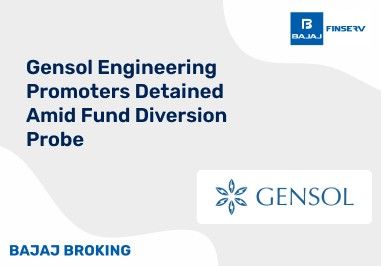BAJAJ BROKING
Ather Energy IPO is Open!
Open a Free Demat Account
Trade Now, Pay Later with up to 4x
Track Market Movers Instantly
What Is Backstop in Stock Market: A Comprehensive Guide
So, to evaluate the worth of an IPO, you must look into other crucial factors like the company’s reasons to raise capital, its financial strength and long-term growth prospects. If you deem a company as a worthy investment based on the above factors, all you need to do is open a Demat account with a trusted stock broker like Bajaj Broking. You can then begin your investment journey and achieve your financial goal.
Have you ever wondered what happens if the shares that a company issues are not entirely subscribed? This is known as under-subscription, and although rare, it can occur. While this may not be of any significant impact to you as the investor, it can be quite disadvantageous to the company that has issued the shares because the capital raised via the issue will be less than the capital the company requires.
Here is where the benefits of a backstop can be useful for the company going public. Not sure what is backstop and why it’s necessary? Let’s get into these details so you can understand the stock market better. To begin with, check out the different types of capital before moving on to the meaning of a backstop.
The Different Types of Capital
Knowing the different types of capital can help you understand the concept of a backstop better.
- Authorised Share Capital
The maximum amount of share capital a company is legally allowed to issue is termed the authorised share capital.
- Issued Share Capital
A subset of authorised share capital, issued share capital represents the portion that has been issued to the public.
- Subscribed Share Capital
Subscribed share capital refers to the portion of capital that has been subscribed by the public. It is a subset of issued share capital.
Additional Read: How Much Can You Earn From Stock Market
What is a Backstop?
Every company that issues an Initial Public Offer appoints an investment bank as a Book-Running Lead Manager (BRLM). In addition to assisting the company in making the issue a success, the BRLM also underwrites the IPO.
A backstop is a financial contract between the company issuing an IPO and the Book-Running Lead Manager, where the BRLM agrees to purchase any leftover unsubscribed shares from the issue. A backstop essentially acts as an insurance policy for the share-issuing company since it guarantees a full subscription, enabling the company to raise the entire capital without any shortfall.
However, this contract is only enforced in the case of under subscription. If all of the shares issued via the IPO are subscribed by the public, the backstop automatically becomes void and unenforceable since there are no unsubscribed shares.
Additional Read: bracket order in the stock market
How Does a Backstop Work?
Now that you’re aware of the meaning of a backstop, let’s look at a hypothetical example to understand how it works.
A company, ABC Limited plans to issue 50,000 shares to the public for the first time through an IPO. The company has appointed an investment bank as a Book-Running Lead Manager and has also entered into a backstop agreement with it.
Now, at the time of subscription, let’s say that only 35,000 shares of the company were subscribed by the public. Since this is a classic case of under subscription, the company decides to enforce the backstop agreement it entered into with the BRLM.
As per the terms of the contract, the BRLM purchases the remaining 15,000 unsubscribed shares, ensuring that the issue is fully subscribed. Once these 15,000 shares are allotted, the lead manager may choose to either hold onto the shares or sell them on the secondary market once the company’s shares are listed on the stock exchanges.
Additional Read: What are Authorised Stocks?
Different Types of Backstops
There are three different kinds of backstop contracts a company can enter into. Here’s a closer look.
- Backstop in IPOs
As you’ve already seen, an IPO backstop guarantees a full subscription and ensures that the issuing company raises the entire capital without any shortfalls. Since the lead manager is contractually obligated to purchase all the unsubscribed shares in a public issue, the share-issuing entity typically pays a backstop fee to cover the risk taken by the lead manager.
- Backstop in Private Equity Deals
Private equity firms routinely acquire companies using a method known as leveraged buyout. In a leveraged buyout, the funds required for the acquisition are arranged through a combination of debt and equity.
Sometimes, private equity firms may not be able to secure the necessary funding required to complete the acquisition. To avoid such situations, private equity firms enter into a backstop agreement with a financial institution, where it agrees to step in with the necessary funds if the firms fail to secure funding for an acquisition.
- Backstop in Financial Management
Many companies enter into backstops with financial institutions to manage their cash flows better. Also known as liquidity backstops, companies use these agreements to meet short-term financial obligations or emergency cash requirements. Such backstop contracts can be in the form of a line of credit, revolving credit facility or commercial paper.
Additional Read: Be Aware of Buy and Hold strategy in the Stock Market
Conclusion
The meaning of backstop is to provide last-resort support in a securities offering for the unsubscribed portion of shares. It is important for investors to understand what a backstop is and why it is necessary for companies that issue shares and other securities. As an investor, the level of subscription may have little influence on your investment decisions.
Share this article:
Read More Blogs
Disclaimer :
The information on this website is provided on "AS IS" basis. Bajaj Broking (BFSL) does not warrant the accuracy of the information given herein, either expressly or impliedly, for any particular purpose and expressly disclaims any warranties of merchantability or suitability for any particular purpose. While BFSL strives to ensure accuracy, it does not guarantee the completeness, reliability, or timeliness of the information. Users are advised to independently verify details and stay updated with any changes.
The information provided on this website is for general informational purposes only and is subject to change without prior notice. BFSL shall not be responsible for any consequences arising from reliance on the information provided herein and shall not be held responsible for all or any actions that may subsequently result in any loss, damage and or liability. Interest rates, fees, and charges etc., are revised from time to time, for the latest details please refer to our Pricing page.
Neither the information, nor any opinion contained in this website constitutes a solicitation or offer by BFSL or its affiliates to buy or sell any securities, futures, options or other financial instruments or provide any investment advice or service.
BFSL is acting as distributor for non-broking products/ services such as IPO, Mutual Fund, Insurance, PMS, and NPS. These are not Exchange Traded Products. For more details on risk factors, terms and conditions please read the sales brochure carefully before investing.
Investments in the securities market are subject to market risk, read all related documents carefully before investing. This content is for educational purposes only. Securities quoted are exemplary and not recommendatory.
For more disclaimer, check here : https://www.bajajbroking.in/disclaimer
Our Secure Trading Platforms
Level up your stock market experience: Download the Bajaj Broking App for effortless investing and trading













